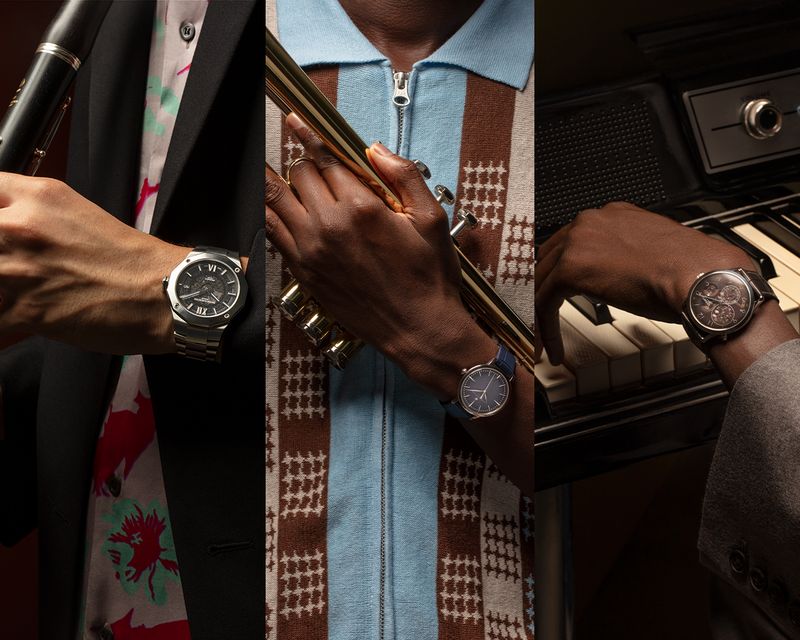THE JOURNAL

“Were you rushing or were you dragging?” It’s the simple question that Mr JK Simmons uses to torment Mr Miles Teller in the 2014 movie Whiplash, as the latter’s timekeeping – or, more accurately, his self-esteem – is torn apart by the former’s abusive methods as a conductor. In more than a decade of visiting Swiss watch factories, I have never witnessed anyone so much as raise their voice above a respectful pitch, let alone throw a chair at a technician’s head. However, the quest for perfect accuracy would be familiar to any watchmaker.
On the face of it, the connection between watchmaking and music is so obvious as to be almost difficult to express in words. “They both… rely on time?” a friend eventually settled on, as I voiced the topic – with a worried look, as if I’d just asked what walking and running had in common and there had to be a trick element to the answer.


As we’ve tried to convey from our video with the talented musician DoomCannon and his band – as well as the photoshoot you see here – there are plenty more areas of common ground between the two. Mastery of each relies on years of practice. Precision plays a role, but, as all master watchmakers will tell you, so does a degree of intuitive, natural feel.
For all the technological advances that have been made in the past half century or so, both remain analogue disciplines at heart. And the business of making both watches and musical instruments is similarly rooted in hand craft – the intricacy and fluidity of a saxophone, trumpet or guitar, and the detail with which they are polished and finished is entirely reminiscent of a hand-finished watch movement.
Going a bit deeper, you come back to the same ineffable territory – isn’t it all just about humankind’s relationship with, and means of expressing, time? Well, yes and no. The earliest known attempts to measure time are ancient Egyptian sundials, dating back some 5,000 years. For millennia before that, prehistoric man’s understanding of time was limited to day and night and a crude appreciation of the seasons. But archaeologists have uncovered remnants of bone-carved woodwind instruments dating back around 40,000 years – so it seems credible that simpler, rudimentary percussion instruments could have existed far earlier.


Neuroscientists, meanwhile, have shown that humans’ ability to detect and imitate rhythm is hard-wired into our brains, and studies have demonstrated that apes, elephants and parrots can also display an understanding of keeping time. Clearly, the ability to hold a beat is more fundamental, and doesn’t rely on the means to measure time.
Even once humanity had started to take an interest in timekeeping, it would be a few more thousand years before man-made devices could count out a beat. Early horology was concerned with how long something lasted, not how funky it was along the way.
In 1588, Galileo first noted the principle of a pendulum. By 1656, Mr Christiaan Huygens had developed the concept of an escapement, which would allow a pendulum with a power source (eg, a wound spring) to beat regularly at a controlled frequency. The invention of precision timekeeping – such as it was; it would still be some time before watches displayed even remotely consistent daily accuracy – certainly played a role in the foreshadowing of the industrial age. But it doesn’t appear to have had an enormous impact on composers of the Baroque or early Classical periods.
It wasn’t until Mr Dietrich Winkel invented the metronome in 1814 that musical notation could be accompanied by a set indicator of speed (Mr Ludwig van Beethoven, in 1815, is acknowledged as being the first composer to do so). Before then, everyone still relied on commonly-agreed perceptions of how fast or slow a piece should be played, guided by Italian descriptions that were sometimes simple and sometimes less so, as epitomised by the idiosyncratic “allegro ma non troppo”, or “fast, but not too much”.


Another 50 years would elapse before the advent of sound recording. Thanks to Mr Thomas Edison’s phonograph, invented in 1877, music could be accurately reproduced and, for the first time, separate audiences could have an identical experience of a piece of music. It can be puzzling for us to contemplate, in our digitally-ordered, technologically filtered world of music where everything is served to us via global streaming services, but this is where modern music really began.
It doesn’t take a huge leap of imagination to think that this also signalled a shift in the musician’s relationship with time; the orchestras of yesteryear were hardly slapdash amateurs, but the scrutiny of a multi-track studio engineer leaves nowhere to hide. Between the 1880s and 1930s, technology changed music forever, rapidly progressing from wax cylinders and gramophones to tape recording and radio. Timekeeping would not have its technological revolution for another generation, but had its own “moment of modernity” at the turn of the 20th century as the watch moved from pocket to wrist.
At this point, although it’s easier to see with hindsight, the path was set – the path that would see watches become style icons and musicians rise to the level of global celebrity. And horology and music would walk it together, intertwined by the tastes of everyone from Mr Miles Davis to Mr John Mayer, Mr Tupac Shakur to Mr Ed Sheeran and hundreds more besides.
We’ve seen musicians collaborate on limited-edition watch designs, and watches embrace their own musicality, perfecting centuries-old mechanical technology with 21st-century material science to create chiming repeaters of remarkable acoustic ability. And to this day, whether a luxury watch is more likely to be flashed as a courtside flex than used to check the bpm of a new single, it’s a path they continue to walk together. The fundamental human impulse to measure our time on this Earth, and the songs we play along the way.